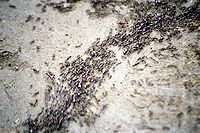
Photo from wikipedia
To track the target in a video, current visual trackers usually adopt greedy search for target object localization in each frame, that is, the candidate region with the maximum response… Click to show full abstract
To track the target in a video, current visual trackers usually adopt greedy search for target object localization in each frame, that is, the candidate region with the maximum response score will be selected as the tracking result of each frame. However, we found that this may be not an optimal choice, especially when encountering challenging tracking scenarios such as heavy occlusion and fast motion. In particular, if a tracker drifts, errors will be accumulated and would further make response scores estimated by the tracker unreliable in future frames. To address this issue, we propose to maintain multiple tracking trajectories and apply beam search strategy for visual tracking, so that the trajectory with fewer accumulated errors can be identified. Accordingly, this paper introduces a novel multi-agent reinforcement learning based beam search tracking strategy, termed BeamTracking. It is mainly inspired by the image captioning task, which takes an image as input and generates diverse descriptions using beam search algorithm. Accordingly, we formulate the tracking as a sample selection problem fulfilled by multiple parallel decision-making processes, each of which aims at picking out one sample as their tracking result in each frame. Each maintained trajectory is associated with an agent to perform the decision-making and determine what actions should be taken to update related information. More specifically, using the classification-based tracker as the baseline, we first adopt bi-GRU to encode the target feature, proposal feature, and its response score into a unified state representation. The state feature and greedy search result are then fed into the first agent for independent action selection. Afterwards, the output action and state features are fed into the subsequent agent for diverse results prediction. When all the frames are processed, we select the trajectory with the maximum accumulated score as the tracking result. Extensive experiments on seven popular tracking benchmark datasets validated the effectiveness of the proposed algorithm.
Journal Title: IEEE Transactions on Image Processing
Year Published: 2022
Link to full text (if available)
Share on Social Media: Sign Up to like & get
recommendations!